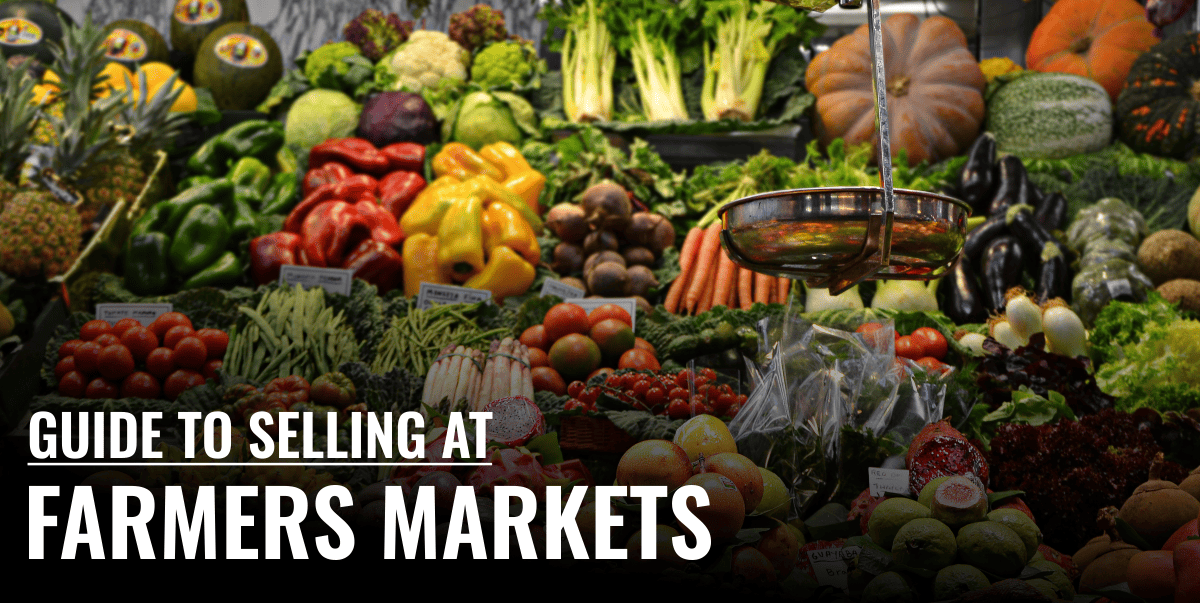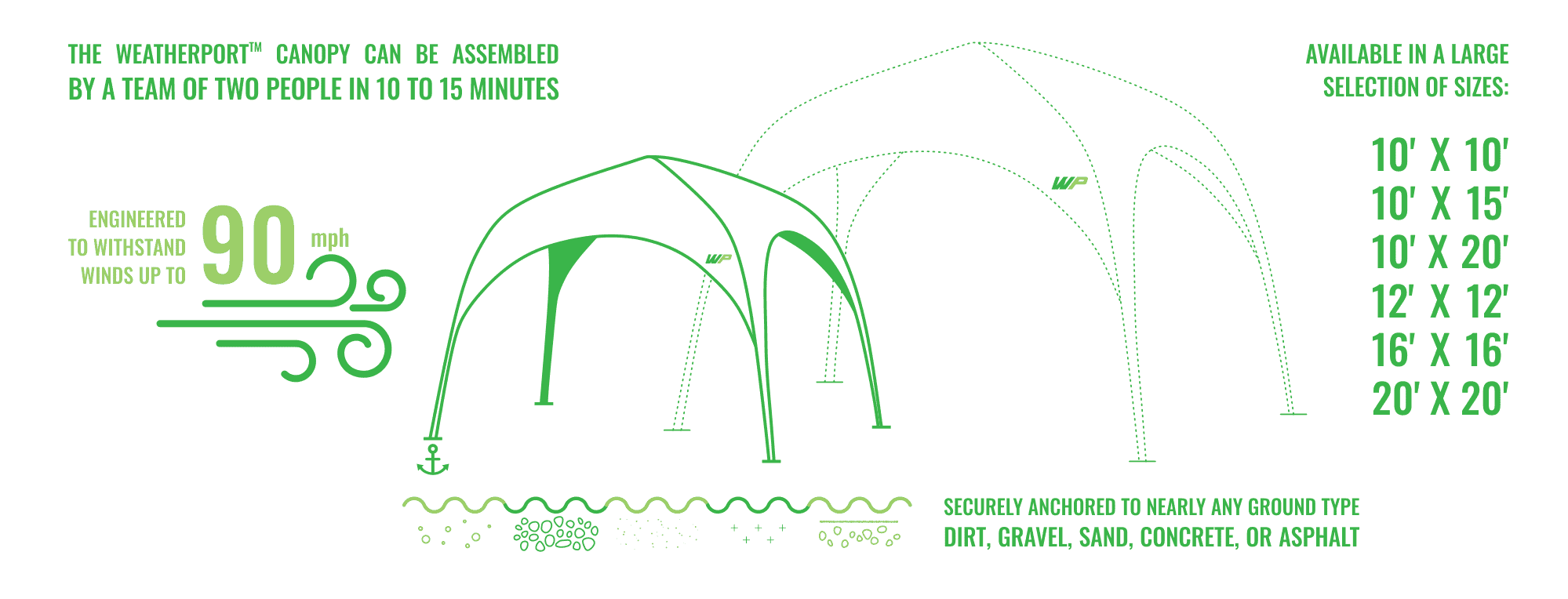
Farmers markets bring to mind images of fresh, colorful, and locally grown produce, handmade goods, the smells of fresh bread and pastries just out of the oven from artisanal and craft bakeries, tastes from local restaurants, live music, fresh flowers from local nurseries, cups of locally roasted coffees, teas, hand-harvested honey, local makers of therapeutic products, and so much more! As with any business venture, there are many “i’s to dot” and “t’s to cross” before you can begin selling at a farmers market. If you’re considering selling your handmade items at a farmers market, or are undecided if selling at a farmers market is the right choice, this guide will help you by providing the steps necessary to get a booth and start selling at your local farmers market!
Below is a brief step-by-step guide to become a farmers market vendor. We will cover these items in greater detail below.
- Do ‘market’ research to help you choose the right farmers market for your business.
- Understand and obtain permits for county, state, and local laws if you plan to sell goods or prepare foods.
- If required, obtain the needed insurance coverage.
- Apply to become a farmers market vendor.
- Once accepted, prepare by following the mantra: organize, prioritize, strategize, mobilize, and energize.
a. Organize yourself by creating an extensive list of everything you need to have prepared.
b. Prioritize the list to accomplish time-intensive and more important items first.
c. Strategize how best to display and market your products.
d. Learn how to mobilize your farmers market stand. Learn how to quickly setup your outdoor canopy structure and pack your vehicle or trailer the night before.
e. Energize by getting a good’s night sleep before your first market!
Benefits of Selling at a Farmers Market
Setting up a booth and selling at a farmers market allows you to have face-to-face time with your customers. It’s a great way to directly connect with one-time visitors and vacationers that happen to quickly stop in while exploring the town, as well as a chance to get to know and enjoy the company of local shoppers that return week after week.

From a business perspective, the start-up costs to sell at a farmers market are much lower than if you were to consider purchasing or leasing a storefront in or near a popular shopping area. In some cases, a certified farmers market (a market run by a non-profit group) may advertise for the vendors and local farmers, saving you and your business from expensive marketing costs.

Selling at a farmers markets provide business owners with immediate feedback. Most farmers markets start in the morning and run to the early- to mid-afternoon. Experienced shoppers that frequent local farmers market know the selection of the freshest produce or availability of handmade goods will be best in the early morning, before the mid-morning and noon rush. It’s very telling to learn what goods you are selling that are or are not popular by 1 p.m. – the seemingly ‘magical’ farmers market time when most high-demand goods will have been purchased. As a self-proclaimed professional farmers market shopper will tell you, “By 1 p.m., you’re lucky if there is anything of value left.” While this may not ring true for every farmers market out there, the idea of popular goods quickly selling provides immediate feedback and allows first-time vendors as well as experienced sellers to quickly change their farmers market selling strategy to provide more of the produce and goods shoppers want to purchase.

Getting immediately paid is another benefit to selling at a farmers market, especially for first time business owners! There are many suggestions for how to shop at a farmers market. The top most recommended piece of advice is for shoppers to bring cash. It’s important as a first-time vendor to not only have a great looking farmers market booth and the goods to sell, but also remember to bring a locking cash box with an assortment of big and small bills. And while cash still talks, you don’t want to turn potential customers away that prefer to use cards. There are many handheld or devices that attach to your mobile device for completing card transactions.
Additional Considerations for Selling at a Farmers Market
While there are many advantages to becoming a vendor and selling at a farmers market, there are also some disadvantages that should be considered.
Depending on the farmers market, some may choose to operate seasonally or year-round. As a potential vendor, it is your responsibility to know the farmers market hours of operations. As well as to plan accordingly to keep from getting drenched and cold during the cooler seasons! We’ll touch on this more later in the guide, but we recommend investing in a high-quality outdoor canopies that provides an aesthetically unique look and are designed to help you stay warm and dry!
Farmers markets typically occur over the weekend, sometimes also on a day during the week. If you are a local farmer, this may mean time away from the farm. Or it may require putting in additional hours during the week to produce the goods that you can’t keep on the shelves, and in time for the next scheduled farmers market. Being sure to understand and commit the hours needed to be successful should be carefully considered.
Getting Started – How to Become a Farmers Market Vendor
Each state has unique guidelines, programs, contacts, and resources for first-time or established businesses wishing to become a farmers market vendor. For information specific to each state (including Puerto Rico), we recommend visiting the Farmers Market Coalition, which provides an extensive number of resources, including farmers market association contacts, as well as information on EBT, SNAPS, and food access programs.

How to Choose the Right Farmers Market
If you live in an area that has more than one farmers market, you’ll want to do some ‘market’ research to determine which is the best for your business. We recommend attending each one and spending the time to analyze and understand the level of competition, noting similar products that are available and how much they are selling for, who and what “anchor” vendors are selling, access and traffic to the location, nearby availability of parking and amenities that may attract or detract potential customers. Gain a first-hand experience and feel for the potential of each farmers market in your area.
Make some calls. After getting an idea of which farmers markets might be best for your business, we recommend contacting the organizers of the farmers market. Be upfront that you are potential vendor and would like to know the following information to help you decide on choosing the right farmers market:
- Do you have booth space available for new vendors?
- If not, ask if there is a wait list, how many pending vendors are ahead of you, and how many vendors they typically take off the list each season or year? This will give you a good indication if the farmers market is popular and vendor booth space is in high demand. It will also give you an idea of how long you may have to wait for a booth space to open before you can become a farmers market vendor at that location.
- What are the space and vendor fees to sell at the farmers market?
- Are there reduced space and vendor fees for local “mom and pop” vendors vs. established businesses? This could mean paying less for vendor space!
- What is the weekly average number of customers?
- Do you have season or yearly sales totals?
- Does the farmers market advertise, hold special events like eating contests, cooking competitions, vendor demo days, educational events, tasting events, music, kids activities, or shop fresh with a chef activities, to increase customer attendance and enjoyment?
- When does the farmers market season begin and end? Or is the farmers market open year-round? If you are a local farmer wanting sell produce, be sure to look at your growing schedule and make sure that aligns with the farmers market season. Some markets may allow you to commit to a partial season.
- Do you offer special holiday markets around Thanksgiving and Christmas? This could either cut into your holiday plans or mean additional opportunities for business!
- Does the farmers market provide an outdoor canopy structure or are you responsible for bringing and setting up my own? It might also be good to ask if there are restrictions on choice of color, adding logos, or using a canopy design that is different from the typical pop-up canopies, like an outdoor canopy structure from WeatherPort®?
If you are responsible for bringing your own farmers market canopy, be sure to ask the organizer what is the best method for safely securing your canopy to prevent it from blowing away and injuring attendees! Are you able to use ground spikes? Are there buried anchors you can connect to? Or do you need to bring or use your own canopy weights? The requirements for securing your farmers market canopy should be covered in the rules document. - Is the farmers market a sole proprietary, partnership, privately owned, a limited liability corporation (LLC), a marketing cooperative, or a 501(c) non-profit business?
- Can I get a copy of the farmers market bylaws and rules? A well-run and managed farmers market will typically have a Statement of Purpose, a Rules document, and Bylaws for defining the legal structure of the farmers market. These documents may be lengthy and include wording or verbiage that doesn’t make sense to someone who isn’t a lawyer. For that reason, we recommend you ask the organizer lots of questions and potentially seek legal counsel to ensure you understand and are complying with the rules and bylaws of the farmers market.
- When reviewing the rules and bylaws, pay special attention to learn if vendors at the farmers market need personal and/or product liability insurance coverage.
- You should also find out if the farmers market you are interested in requires vendors to sign a Hold Harmless Clause – releasing the market from any harm done by the vendor or the vendor’s products. If this is the case, be sure to ask if the market’s liability coverage will or will not protect vendors against losses related to individual products. If you require farmers market insurance, we recommend contacting insurance companies to get coverage.
- Is your farmers market permitted and adhering to zoning restrictions? You want to make sure the organizer is operating in compliance with the city and state laws. Versus joining a handful of vendors illegally occupying a space and risk being fined or shut down.
- Ask where or how do you obtain an application to apply and become a vendor at the farmers market.
Now that you have personally attended, gained first-hand experience, talked with the market’s organizer, have read the rules and bylaws, understand the time commitment involved, and have the application to apply and become a vendor at a farmers market, it’s time to make an informed decision and choose the right farmers market for your business!
Apply to be a Farmers Market Vendor
If you plan to prepare or sell food at a farmers market, we recommend you learn and understand the requirements for obeying local, state, and federal rules prior to submitting an application to become a farmers market vendor. This may require being certified by the Board of Health (or similar agency) in your county, obtaining a health or food handler permit, as well as understanding how selling prepared foods need to be properly labeled.
Applying to become a vendor at a farmers market is done by completing an application. The application will provide you with a list of the additional items needed, like insurance. Be sure you follow the instructions on how to submit and double check you are sending a complete farmers market application to reduce the potential of being rejected. An incomplete application will require more time on your part, but also waste the market organizer’s time. You want to make sure you are (and remain) in good favor with the market organizer to enjoy a long-lasting and successful farmers market experience!
Upon acceptance, the organizer will ask you to sign a market contract. Be sure you have read the contract, rules, and bylaws so you fully understand what is required and expected of being a vendor at a farmers market!
While you don’t want to hold up the process of becoming an approved farmers market vendor and delay making money, it is okay to ask the organizer if you can have a few days to do your due diligence and review the market contract. We recommend stating a specific date and time that you plan to have the signed contract back to them, and then working hard to make sure you are in compliance and understand the contract you are signing. This sets an expectation for you and conveys a sense of urgency to the market organizer that you are taking the contract and consideration of becoming a vendor seriously.
Preparing for Your First Farmers Market Experience
Before we spend all our creative efforts on designing a farmer’s market booth, let’s review some tips for beginner farmers market vendors! There is still plenty of work to be done!
Organize, prioritize, strategize, mobilize, and energize! Follow that mantra, and you’ll have your farmers market stand ready in no time!

Organizing for a Farmers Market
Get organized by creating a checklist of everything you’ll need to be fully prepared to sell at a farmers market! We recommend making a starting checklist to make sure you have what you need leading up to and attending your first farmers market. And then as you go along and begin to become more proficient with preparing and selling, work on creating and fine-tuning a checklist for each day of the farmers market to consistently make sure you have everything you need and to avoid any last-minute panics. Especially as a new vendor to a farmers market, you want other vendors and potential customers to think this comes naturally and you’ve been doing it for years. You know the reality, it’s a lot of hard work!
Farmers Market Vendor Priorities
Once you have created your farmers market checklist, it’s time to carefully look at the list and prioritize the tasks that need to be done first. If you know your first farmer’s market is in two weeks, and it takes 9 days to produce the goods you intend to sell, this should be an item that is moved to the top of the list. Tackle the big and time-intensive items on your list first. This will ensure the important items are taken care of if you happen to run out of time.
Strategies for Farmers Market Vendors
Devoting time to think of strategies for your farmers market stand is important. Just as any business needs to carefully and creatively think how they will market to potential customers, this is the time for you to sit down, look at your market research and do the following:
- Set pricing for the goods you intend to sell at the farmers market.
- Determine how you want to appeal, market to and attract customers.
- Think of ways how to describe your product as being different from similar items sold at the farmers market.
- Design and produce signage with your business name, logo, informational pamphlets about your products, newsletters and sign-up sheets, and table-top signs with pricing.
Be sure to include signage showing what forms of payment you accept. You’d be surprised how many farmers market vendors don’t display what forms of payment they accept. Not displaying the types of payment you accept results in last minute confusion, purchasing delays, frustration, and ultimately lost customers. If you allow payments from mobile devices, we recommend you practice and familiarize yourself with how the technology works, so you aren’t fumbling around, trying to figure how to process a payment or print out a receipt while a line of customers wanting to purchase your goods grows.
How to Choose the Best Canopy for Farmers Markets
When choosing a canopy structure that is going to be used outdoors, we suggest looking at a canopy structure that provides a higher degree of safety and is designed to last a long time. Unexpected changes in weather can quickly turn a warm sunny day into a farmers market nightmare. Strong wind gusts, dust devils, and sudden storms can transform a store-bought pop-up canopy (typically available for a couple hundred dollars) into a flying and gnarled mess of razor-sharp metal. They are also susceptible to collapsing under high winds or heavy rains and risk injuring you and customers, not to mention damaging products you worked hard to bring to the market and sell.
A farmers market canopy also needs to be designed to withstand the rigors of frequent setup and taken down cycles. Investing in an accordion canopy tent is a money losing strategy for vendors selling at farmers markets. The hallow tubing and plastic fasteners of easy-up canopy tents are not designed for prolonged use and quickly weaken with continued setup and take downs. You’ll be lucky if you can make it through one or two market seasons without having to replace your canopy tent.
 When it comes to farmers market canopies, the saying “you get what you pay for” couldn’t be more true. Given the disposable nature of pop-up canopy tents, why not look for a high-quality outdoor canopy structure that will last years, if not decades? We encourage you to look at a Colorado-based company called WeatherPort®! In doing our research, their outdoor canopy structures are engineered to withstand winds up to 90 miles per hour (they have a canopy wind test video available on YouTube). They can also be securely anchored to nearly any ground type, including dirt, gravel, sand, concrete, or asphalt. Ballast systems (heavy-duty canopy weights) are available for markets that don’t allow ground spikes.
When it comes to farmers market canopies, the saying “you get what you pay for” couldn’t be more true. Given the disposable nature of pop-up canopy tents, why not look for a high-quality outdoor canopy structure that will last years, if not decades? We encourage you to look at a Colorado-based company called WeatherPort®! In doing our research, their outdoor canopy structures are engineered to withstand winds up to 90 miles per hour (they have a canopy wind test video available on YouTube). They can also be securely anchored to nearly any ground type, including dirt, gravel, sand, concrete, or asphalt. Ballast systems (heavy-duty canopy weights) are available for markets that don’t allow ground spikes.
The WeatherPort™ Canopy can be assembled by a team of two people in 10- to 15-minutes, and is available in a large selection of sizes: 10’ x 10’, 10’ x 15’, 10’ x 20’, 12’ x 12’, 16’ x 16’ and 20’ x 20’. They have 4-sided canopy designs that can be equipped with side curtains, powder-coated high-strength steel or lightweight aluminum frames. Bright colors or color patterns are available if you want to create an eye-catching farmers market canopy with contrasting patterns. We recommend spending the extra money to really make your farmers market canopy stand out by adding your business name, logo, product name, or combination of all three to your outdoor canopy structure!
WeatherPort™ has an in-house printing capability to brand your farmers market canopy with high-resolution logos, images, and designs directly to their tensioned membranes. Look at their Branded Canopy page!
The canopy structure you choose will be the first thing potential customers see, so it needs to stand out from the crowd of boring white pop-up canopies.
Staffing Strategies for Farmers Market Vendors
Another important aspect of selling at a farmers market is to decide if you are going to go it alone, or if you plan to have a business partner or friend help staff your booth. A word of advice, it’s much easier to step away for a quick lunch or bathroom break, to share the work load of setting up and taking down the booth, as well as being able to spend more one-on-one time with customers – if you share the effort!
Learn How to Setup and Take Down Your Farmers Market Booth
Next comes mobilizing. We recommend you practice setting up and taking down your farmers market stand multiple times before your first market experience! Familiarize yourself with how your outdoor canopy structure goes together, how long the entire process takes, how to hang your business name and logo sign, setting up the tables, chairs, accessories, decorations, and how to best display your goods. Be sure to step back and approach how your booth looks from a customer’s point of view.
In addition to becoming an expert at setting up and taking down your farmers market stand, we recommend you practice loading and unloading everything to and from your car, van, truck, or trailer. You don’t want to be frantically cramming items into your car the night before, only to realize it doesn’t all fit. Once you have transportation and how to efficiently pack your supplies and goods figured out, we recommend packing it one last time the night before your first market day! If you are using a trailer, attach the trailer the night before. This will save you time in the morning.
A Lesson Learned from Farmers Market – Get a Good Night’s Sleep
The last step in preparing to sell at farmers market is to energize! It’s the day before your first market. You’ve got your checklist completed, the vehicle is packed (or trailer attached), you have your cash box and change, and the clothes you are going to wear laid out. You are ready!
Just as the word “energize” would suggest, try to avoid staying up late the night before. Farmers markets typically start early on Saturday and Sunday. As a vendor, you’ll need to get there even earlier to setup. If possible, we recommend going earlier than the suggested set-up time, so you are there before other vendors and give yourself extra time.
It’s business critical to get a good night’s sleep. Gone are the college days of staying up all night and cramming for a test – which we now know is not effective. You need to bring your ‘A’ game and have the energy and positive attitude to directly engage customers (and sell lots of product)!
Money-Making Tips for Farmers Market Vendors
In addition to setting your farmers market prices to cover your costs, including materials and labor, below are some additional money-making tips for farmers market vendors!
 1. Be social! Greet each potential customer that walks by your booth with a friendly “Hi!” or “Good Morning!” Besides being courteous and friendly, it is also a proven technique to get people wrapped up in the excitement of attending a farmers market and likely to walk by your booth to stop and briefly focus on your booth. It only takes a couple seconds of thought for their curiosity to be sparked or to become interested in what products you have for sale.
1. Be social! Greet each potential customer that walks by your booth with a friendly “Hi!” or “Good Morning!” Besides being courteous and friendly, it is also a proven technique to get people wrapped up in the excitement of attending a farmers market and likely to walk by your booth to stop and briefly focus on your booth. It only takes a couple seconds of thought for their curiosity to be sparked or to become interested in what products you have for sale.
 2. Show those pearly white teeth and smile, even if you think nobody is around. You never know when a potential customer might walk by. A friendly smile is an inviting and welcoming gesture for potential customers.
2. Show those pearly white teeth and smile, even if you think nobody is around. You never know when a potential customer might walk by. A friendly smile is an inviting and welcoming gesture for potential customers.
 3. After you’ve taken a handful of great photos of your booth all setup, products you are selling, and asked for your followers on social media to come visit you in-person at the farmers market, it’s time to silence (or turn off) your phone and put it away. Yes, it’s the weekend and your friends are probably posting some amazing photos of their morning adventures, but you are there to sell. If you’re more actively engaged with your phone and focused on social media, you’ll miss potential sales with customers walking by. From a customer’s perspective, being intently focused on your phone conveys that you are either very anti-social or too busy to engage with them. This is the exact opposite how you want customers to feel at a farmers market. If you need to take a call, or just can’t resist the temptation of staying up to date with all your friends on social media, we recommend you step away from the booth.
3. After you’ve taken a handful of great photos of your booth all setup, products you are selling, and asked for your followers on social media to come visit you in-person at the farmers market, it’s time to silence (or turn off) your phone and put it away. Yes, it’s the weekend and your friends are probably posting some amazing photos of their morning adventures, but you are there to sell. If you’re more actively engaged with your phone and focused on social media, you’ll miss potential sales with customers walking by. From a customer’s perspective, being intently focused on your phone conveys that you are either very anti-social or too busy to engage with them. This is the exact opposite how you want customers to feel at a farmers market. If you need to take a call, or just can’t resist the temptation of staying up to date with all your friends on social media, we recommend you step away from the booth.
 4. Use the same farmers market staff each week. Repeat customers will get to know and recognize them. And try remembering your customer’s names. This will make them feel important, valued, and are more likely to make your booth the first stop each week!
4. Use the same farmers market staff each week. Repeat customers will get to know and recognize them. And try remembering your customer’s names. This will make them feel important, valued, and are more likely to make your booth the first stop each week!
 5. Come up with talking points that help establish value with your products. Did you or your family grow the produce you have on sale on your family farm? Is it certified organic? Know what is currently in and going out of season, so you can help guide potential customers of what they should be looking to purchase now and what they can expect by returning to your booth at the next farmers market. If you have unique fruits, vegetables, or herbs that people are not familiar with, be sure to prepare an explanation of what it is and how you use it. You might also offer sample tastings and recipes that use it!
5. Come up with talking points that help establish value with your products. Did you or your family grow the produce you have on sale on your family farm? Is it certified organic? Know what is currently in and going out of season, so you can help guide potential customers of what they should be looking to purchase now and what they can expect by returning to your booth at the next farmers market. If you have unique fruits, vegetables, or herbs that people are not familiar with, be sure to prepare an explanation of what it is and how you use it. You might also offer sample tastings and recipes that use it!
 6. If selling produce, try to keep them out of the sun and give them an occasional misting with a spray bottle filled with water and ice. The cooler temperature and moisture will help them look and stay fresh longer.
6. If selling produce, try to keep them out of the sun and give them an occasional misting with a spray bottle filled with water and ice. The cooler temperature and moisture will help them look and stay fresh longer.
 7.Offer email coupons by signing up for newsletters. This is a great way to stay in touch, promote upcoming special events, and provide local residents who buy from your farmers market stand frequently a chance to save money! Encourage customers to come early and take advantage of the best selection of goods. Setting discount prices at the end of the day sets customer’s expectations that they can wait to buy, causing you to lose profit.
7.Offer email coupons by signing up for newsletters. This is a great way to stay in touch, promote upcoming special events, and provide local residents who buy from your farmers market stand frequently a chance to save money! Encourage customers to come early and take advantage of the best selection of goods. Setting discount prices at the end of the day sets customer’s expectations that they can wait to buy, causing you to lose profit.
 8.Consider adding a child or pet friendly element to your booth. This could be as simple as giving children a free vegetable from your farm, adding products for parents to buy for children, or a water bowl for four-legged family members on a hot summer day! The sentiment and thought will go a long way and help increase sales.
8.Consider adding a child or pet friendly element to your booth. This could be as simple as giving children a free vegetable from your farm, adding products for parents to buy for children, or a water bowl for four-legged family members on a hot summer day! The sentiment and thought will go a long way and help increase sales.
 9. In addition to having a supply of brown bags for customers that forgot theirs at home, why not sell some reusable branded totes or baskets? This not only promotes sustainability, but also results in a customer walking around the market with your logo – free advertising!
9. In addition to having a supply of brown bags for customers that forgot theirs at home, why not sell some reusable branded totes or baskets? This not only promotes sustainability, but also results in a customer walking around the market with your logo – free advertising!
 10. Learn to quickly identify the different kinds of people that attend farmers markets. Farmers markets attract a wide group of people. Being able to identify a customer who is serious or may be interested and persuaded to purchasing will help save you time, make more money, and keep you from entertaining the person who’s at the farmers market only for the free samples.
10. Learn to quickly identify the different kinds of people that attend farmers markets. Farmers markets attract a wide group of people. Being able to identify a customer who is serious or may be interested and persuaded to purchasing will help save you time, make more money, and keep you from entertaining the person who’s at the farmers market only for the free samples.
 11. You’ve spent a lot of time and thought designing a farmers market stand that gets people’s attention. All that can go right out the window if you don’t keep it tidy! Use the time between talking and selling to customers to clean, organize, and replenish purchased goods. You want as many good first impressions as possible!
11. You’ve spent a lot of time and thought designing a farmers market stand that gets people’s attention. All that can go right out the window if you don’t keep it tidy! Use the time between talking and selling to customers to clean, organize, and replenish purchased goods. You want as many good first impressions as possible!
 12. Thank each customer for buying your products and supporting local farmers and businesses. Farmers markets offer communities, local farmers, restaurants, and small businesses many advantages. By eliminating the ‘middle-man’, farmers and business owners can start small, with low-barrier entry points, test the market, and grow to a successful business. This savings is often passed onto the consumer shopping at farmers markets, allowing them to purchase conventional or organic produce directly from a local farm (farm-to-table) cheaper than at a supermarket.
12. Thank each customer for buying your products and supporting local farmers and businesses. Farmers markets offer communities, local farmers, restaurants, and small businesses many advantages. By eliminating the ‘middle-man’, farmers and business owners can start small, with low-barrier entry points, test the market, and grow to a successful business. This savings is often passed onto the consumer shopping at farmers markets, allowing them to purchase conventional or organic produce directly from a local farm (farm-to-table) cheaper than at a supermarket.
 13. Keep track of sales so you can easily track profits. There are many bookkeeping apps, programs, and services out there to help you stay organized and chart your hourly, daily, weekly, monthly, seasonal, or yearly success. This collected sales data will be helpful for coming up with new sales strategies to increase efficiency!
13. Keep track of sales so you can easily track profits. There are many bookkeeping apps, programs, and services out there to help you stay organized and chart your hourly, daily, weekly, monthly, seasonal, or yearly success. This collected sales data will be helpful for coming up with new sales strategies to increase efficiency!
Do you have additional money-making tips or suggestions for farmers market vendors? We’d love to hear them. Leave a comment at the bottom of this article!
Is It Spelled Farmer’s Market or Farmers Market?
A question we get asked often enough to include as its own section in this guide: how do you correctly spell farmers market? Is it supposed to be farmer’s market with an apostrophe? No apostrophe?
Here is the answer.
Adding an apostrophe to farmer’s market or farmers’ market makes it possessive. While possible, most farmers markets are not organized or owned by farmers. Hence the spelling farmers market, without the apostrophe.
Have Questions about Farmers Markets?
We hope this guide has provided a thorough and in-depth list of considerations and an easy-to-follow instructions for becoming a vendor and selling at a farmers market!
Should you have additional questions for items not covered in this guide, we recommend you contact your local farmers market organization or visiting the Farmers Market Coalition for additional resources and ways to contact the farmers market association in your state.
More Information on Farmers Market Canopies
Whether you are interested in an outdoor canopy structure for your own farmers market stand or are a farmers market organizer and needing a large fabric structure capable of housing the entire market indoors, we recommend contacting WeatherPort® directly using the information below:
- By telephone: (970) 399-5909
- Send an email inquiry to: info@weatherport.com
- Use WeatherPort’s online contact form